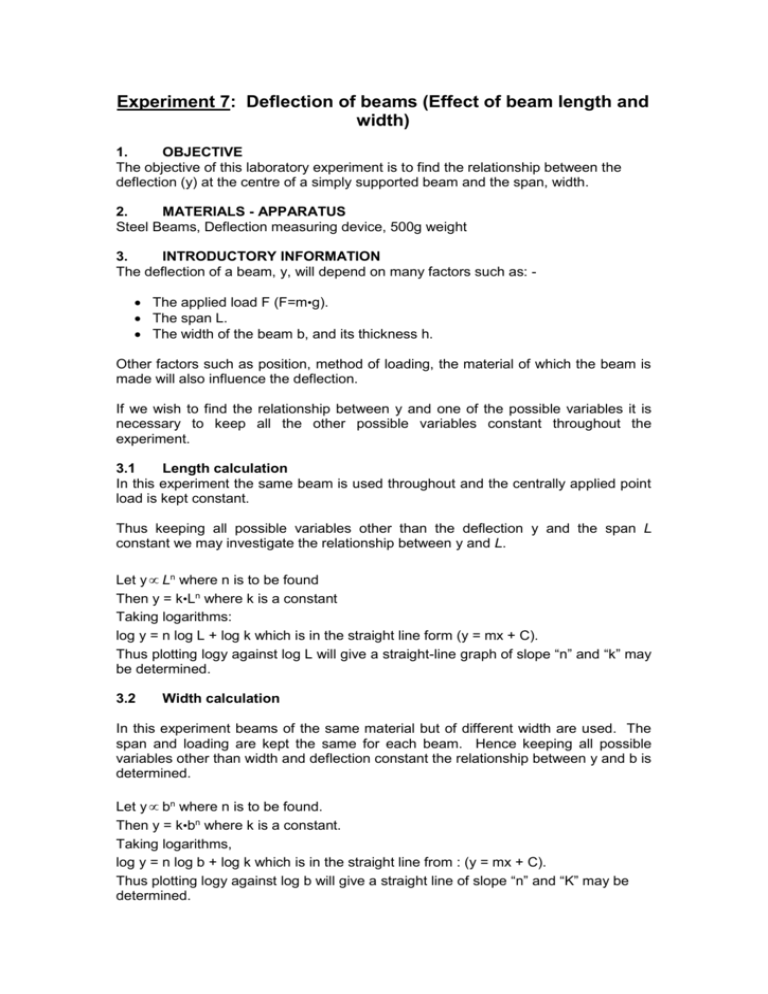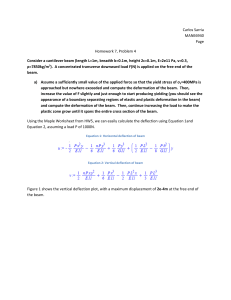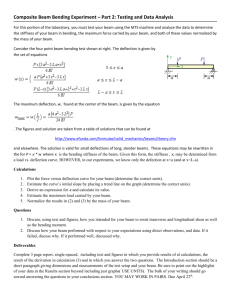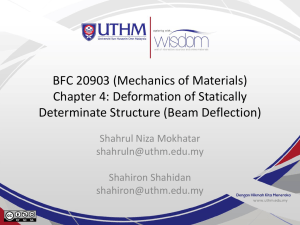Experiment 7: Deflection of beams (Effect of beam length and width)
advertisement

Experiment 7: Deflection of beams (Effect of beam length and width) 1. OBJECTIVE The objective of this laboratory experiment is to find the relationship between the deflection (y) at the centre of a simply supported beam and the span, width. 2. MATERIALS - APPARATUS Steel Beams, Deflection measuring device, 500g weight 3. INTRODUCTORY INFORMATION The deflection of a beam, y, will depend on many factors such as: The applied load F (F=m•g). The span L. The width of the beam b, and its thickness h. Other factors such as position, method of loading, the material of which the beam is made will also influence the deflection. If we wish to find the relationship between y and one of the possible variables it is necessary to keep all the other possible variables constant throughout the experiment. 3.1 Length calculation In this experiment the same beam is used throughout and the centrally applied point load is kept constant. Thus keeping all possible variables other than the deflection y and the span L constant we may investigate the relationship between y and L. Let y Ln where n is to be found Then y = k•Ln where k is a constant Taking logarithms: log y = n log L + log k which is in the straight line form (y = mx + C). Thus plotting logy against log L will give a straight-line graph of slope “n” and “k” may be determined. 3.2 Width calculation In this experiment beams of the same material but of different width are used. The span and loading are kept the same for each beam. Hence keeping all possible variables other than width and deflection constant the relationship between y and b is determined. Let y bn where n is to be found. Then y = k•bn where k is a constant. Taking logarithms, log y = n log b + log k which is in the straight line from : (y = mx + C). Thus plotting logy against log b will give a straight line of slope “n” and “K” may be determined. 4.1 PROCEDURE (Length calculation) a) Mark the centre of the beam on each side of this point mark off distances off 500, 600, 1000 mm. b) With a span of 500 mm measure the height of the central point on the deflection -measuring device. Apply a central load of 500g and measure the new height. c) Repeat 2 for spans of 600, 1000. d) Enter your results in the table below and complete the table e) Plot the graph of log y against log L with log y on the “y” axis and logL on the “x” axis. f) Draw the mean straight line of the graph and measure its slope to determine n. 4.1.1 Results A/A Width b (mm) 1 2 3 4 5 6 Length L (mm) Deflection y (mm) LogL Logy 30 SLOPE = n = y Ln 4.2 PROCEDURE (Width calculation) a) Mark the beams with the same span so that they will be supported near their ends and also mark the mid point of the span. b) Take the beam of largest width, measure the width with the vernier Calipers. c) Support the beam at the two marked supporting points and measure the height of the mid-point with the deflection measuring device. d) Apply the 500 g load as the mid point and once again measure the height at the centre. e) Repeat 2, 3, and 4 for each beam. f) Enter your results in the table below and complete the table. g) Plot the graph of logy against logb with logy on the “y” axis and logb on the “x” axis. h) Draw the mean straight line of the graph and measure its slope to determine n. 4.2.1 Results A/A Length L (mm) 1 2 3 4 5 6 Width b (mm) Deflection y (mm) Logb Logy 800 SLOPE = n = y bn 5. QUESTIONS Plot the graph of log y against log L with log y on the “y” axis and logL on the “x” axis. Determine slope n. How does your result compare with the generally accepted relationship? Plot the graph of logy against logb with logy on the “y” axis and logb on the “x” axis. Determine slope n. How does your result compare with the generally accepted relationship? Calculate the corresponding deflections y, during length calculation (b has constant value), according to the formula shown below. Calculate the corresponding deflections y, during width calculation (b has variables values), according to the formula shown below. Compare the observed and calculated values of deflections y. h=0.004 m 3 F *L =48*E*I y L = length of beam (m) y = deflection of beam (m) F = force (N) E = Young's Modulus (N/m2) I = moment of inertia of beam (m4) Experiment 8: Deflection of beams (Macaulay’s Method) 1. OBJECTIVE To determine experimentally the deflection at two points on a simply-supported beam carrying point loads and to check the results by Macaulay’s method. 2. APPARATUS Beam deflection apparatus, steel beam, two dial test-indicators and stands, micrometer, rule, two hangers, weights. 3. PROCEDURE (Experimental) Assemble the apparatus as shown in fig. 1 with the beam simply supported at its ends A and B. Place load hangers at point C and D distant a and b W1 W2 Y1 A α Y2 C D R1 B b R2 l Figure 1 Respectively from end A. Select two points X and Y approximately in positions shown in the figure and set up the dial gauges to bear at these points on the upper surface of the beam. Zero the dial gauges with the hangers in position. Apply suitable loads W 1 and W 2 at C and D respectively and note the deflections at X and Y as indicated by the dial gauges. Record the values of W 1 and W2 and the corresponding deflections at X and Y. Sketch the arrangement and indicate on the sketch the distances a, b, and l. Also the distances of points X and Y from end A. Measure the cross-sectional dimensions of the beam, using a micrometer. Calculate the deflections at X and Y, using Macaulay’s method and compare the values with the observed results. 4. THEORY Consider the simply-supported beam loaded as shown in fig.2. W1 W2 X A RA α C D B RB b x Figure 2 l For values of x between b and l M XX RA x Wl x a W2 x b (i) For values of x between a and b M XX R A x Wl x a (ii) For values of x between o and a M XX RA x (iii) Egn. (i) gives the bending moment at any section of the beam provided bracketed terms are discarded when they become negative. For this reason, the bracketed terms are known as the “Macaulay Ghost Terms”. EI Since d2y M dx 2 d2y EI 2 R A x W1 ( x a) W2 ( x b) dx (iv) In Macauley’s method, the bracketed terms are intergraded as a whole. This is justified since x1 x1 xx x2 ( x a)dx ( x a)d ( x a) dy x2 W W2 R A ( x a) 2 ( x b) 2 A EI dx 2 2 2 EIy R A x 3 W1 W2 ( x a) 3 ( x b) 3 AX B 6 6 6 (v) (vi) By integrating the bracketed quantities as a whole, the constants A and B have the same values for all values of x. This may be shown to be the case as follows: Put x = a in eqn. (v) and omit the term in (x-b) since it is then negative. Then, EI dy a 2 WI RA (a a) 2 A dx 2 2 RA a2 A 2 For values of x between o and a EI d2y RA x dx 2 EI dy x2 RA A1 dx 2 EI dy a2 RA A1 dx 2 Integrating Putting x = a Since the two equations concern the slope dy/dx at the same point that the constants A and A1 must be equal. Similarly by putting x = b it may be shown that the constant is again A. The actual values of the constants A and B are obtained from the boundary conditions, that is, in eqn. (vi): y = o when x = o and y = o when x = 1 In the particular case considered, B = o. 5. PROCEDURE (Calculations) a) Set up an expression for the bending moment for any section in the extreme right-hand panel of the beam, measuring x from the left-hand end. Put in square brackets, the ‘ghost’ b) Integrate to obtain the slope equation and again to obtain the deflection equation and again to obtain the deflection equation, adding the constants A and B respectively at each stage. Integrate the ‘ghost’ terms as a whole. c) Calculate the constants A and B from the condition that the deflection y is zero at the two values of x corresponding with the supports. Omit negative ‘ghost’ terms. d) To determine slope or deflection at a particular point on the beam substitute the corresponding value of x in the appropriate expression and omit any ‘ghost’ term which may become negative. 5.1 Results Width of beam, b (m) Thickness of beam, d (m) Span, l (m) Load W 1 (g) Load W 2 (g) Distance a (m) Distance b (m) Deflection at Y1 (mm) Deflection at Y2 (mm) Young’s Modulus, E = 210 GPa (assumed) 5.2 Calculations Second moment of area of beam cross-section I= Reaction RA =…………………… bd 3 m4 12 Reaction RB =…………………….. Flexural rigidity EI = By means of Macaulay’s method calculate the deflection at the points X and Y using the appropriate values of x and tabulate the results, as follows: Point Observed Calculated Deflection Deflection 1 2 6. CONCLUSION Compare the observed and calculated values of deflection at the two points and comment on probable causes of discrepancy.







